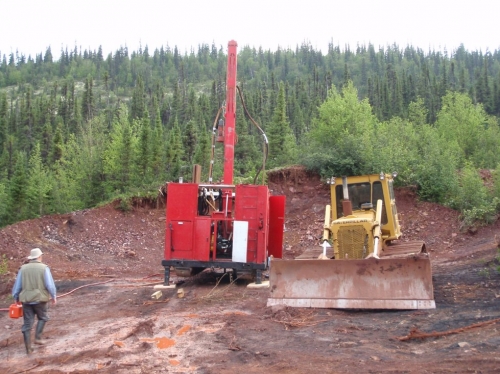 |
Labrador Iron MinesHoldings Limited |
|
 |
Schefferville Area Projects |
Deposit TypesDeposit Types The Labrador Trough contains four main types of iron deposits: Soft iron ores formed by supergene leaching and enrichment of the weakly metamorphosed cherty iron formation; they are composed mainly of friable fine-grained secondary iron oxides (hematite, goethite, limonite). Taconites, the fine-grained, weakly metamorphosed iron formations with above average magnetite content and which are also commonly called magnetite iron formation. Metataconites, more intensely metamorphosed, coarser-grained iron formations which contain specular hematite and subordinate amounts of magnetite as the dominant iron minerals. Hard high-grade hematite ore which occur southeast of Schefferville at Sawyer Lake, Astray Lake and in some of the Houston deposits. The Labrador iron deposits are composed of iron formations of the Lake Superior-type. The Lake Superior-type iron formation consists of banded sedimentary rocks composed principally of bands of iron oxides, magnetite and hematite within quartz (chert)-rich rock, with variable amounts of silicate, carbonate and sulphide lithofacies. Such iron formations have been the principal sources of iron throughout the world. The Sokoman iron formation was formed as a chemical sediment under varied conditions of oxidation-reduction potential (Eh) and hydrogen ion concentrations (pH) in varied depth of seawater. The resulting irregularly bedded, jasper-bearing, granular, oolite and locally conglomeratic sediments are typical of the predominant oxide facies of the Superior-type iron formations, and the Labrador Trough is the largest example of this type. The facies changes consist commonly of carbonate, silicate and oxide facies. Typical sulphide facies are poorly developed. The mineralogy of the rocks is related to the change in facies during deposition, which reflects changes from shallow to deep-water environments of sedimentation. In general, the oxide facies are irregularly bedded, and locally conglomeratic, having formed in oxidizing shallow-water conditions. Most carbonate facies show deep-water features, except for the presence of minor amounts of granules. The silicate facies are present in between the oxide and carbonate facies, with some textural features indicating deep-water formation. Each facies contains typical primary minerals, ranging from siderite, minnesotaite, and magnetite-hematite in the carbonate, silicate and oxide facies, respectively. The most common mineral in the Sokoman Formation is chert, which is closely associated with all facies, although it occurs in minor quantities with the silicate facies. Carbonate and silicate lithofacies are present in varying amounts in the oxide members. The sediments of the Labrador Trough were initially deposited in a stable basin which was subsequently modified by penecontemporaneous tectonic and volcanic activity. Deposition of the iron formation indicates intraformational erosion, redistribution of sediments, and local contamination by volcanic and related clastic material derived from the volcanic centers in the Dyke-Astray area. The consolidation of the sediments into cherty banded iron formation is due to diagenesis and low grade metamorphism which only reached the greenschist rank. The iron may be a product of erosion. It is unlikely that the Nimish volcanism made a significant contribution.
Mineralization
Only the direct shipping ore is considered beneficiable to produce lumps and sinter feed and will be part of the resources for the LIM project. The direct shipping ore was classified by IOC in six categories based on their chemical, mineralogical and textural compositions. This classification is still used in the evaluation of the mineralization. The following ore and mineralization categories not part of the potential economic mineralization, are: High Non-Bessemer (HNB) red, yellow and blue.Lean Non Bessemer (LNB) red, yellow and blue. High Silica (HiSiO2) (waste). Treat Rock (TRX) (waste but previously stockpiled for possible later treatment). The blue ores, which are composed mainly of the minerals hematite and martite, are generally coarse grained and friable. They are usually found in the middle section of the iron formation. The yellow ores, which are made up of the minerals limonite and goethite, are located in the lower section of the iron formation. These ores have the unfavorable characteristic of retaining high moisture content. The red ore is predominantly a red earthy hematite. It forms the basal layer that underlies the lower section of the iron formation. Red ore is characterized by its clay and slate-like texture. Direct shipping ores and lean ores mined in the Schefferville area during the period 1954-1982 amounted to over 150 million tons. Based on the original ore definition of IOC (+50% Fe <18% SiO2 dry basis), approximately 250 million tonnes of iron resources remain in the Schefferville area, exclusive of magnetite taconite. Today LIM has rights to almost two-thirds of this remaining iron resource. |
Home | Corporate Information | Shareholder Information | Projects | Environment & Social | News Center | Contact Us © 2025 Labrador Iron Mines All Rights Reserved | Disclaimer & Privacy Policy |
